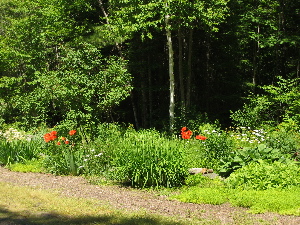BAGWORMS-AGAIN!
OK, they've moved into a tree near me! Not only that, it's at the TOP of the tree! I can't reach it and it's driving me crazy. What to do?
Much to my delight, I found an article that talks about just this problem. It also says that we can help ourselves by planting various forms of plants in the ASTER family (Asteraceae) close to the trees that are affected! The daisy-like blossoms attract little ichneumonid wasps. These little wasps don't bother people at all, but they parasitize BAGWORMS!
The happiest part of that little equation is that it's aster season! Even the wild asters are blooming all over. So, beg, borrow or buy some very attractive asters for your garden. Then plant them relatively near the afflicted trees and hope the little wasps find your garden, and hence your bagworm laden trees.
I've copied part of the article for you so you can get the straight skinny from the original source!
"Plant Daisies to Fight Bagworms
The bagworm (Thyridopteryx ephemeraeformis) is a common pest of many coniferous and deciduous trees in the eastern U.S. This moth’s larvae spin unsightly baglike shelters in tree canopies and can cause serious damage through defoliation. Typical control methods include mechanical removal of the bagworm shelters (when feasible) and the application of pesticides. However, the bagworm has a number of natural enemies —in particular, parasitoid insects, such as ichneumonid wasps—and research at the University of Illinois at Urbana-Champaign has shown that bagworm control by these insects can be enhanced by planting certain flowering plants near trees and shrubs that are susceptible to bagworm infestations. The flowering plants used in the UIUC research were all members of the Asteraceae, or aster family, which includes many species with daisylike blossoms known to attract parasitoids. Among them were a shasta daisy cultivar (Leucanthemum × superbum ‘Alaska’), a cultivar of the Newfoundland aster (Aster novi-belgii ‘Professor Anton Kippenburg’), and the treasure flower (Gazania rigens), a South African native. The bagworm host plant was an arborvitae cultivar (Thuja occidentalis ‘Woodwardii’). In one trial, surrounding host plants with flowers led to a 70 percent increase in the parasitism of bagworms. In another trial, attacks on bagworms by parasitoid insects increased by a factor of three when host plants were surrounded by a high density of daisy flowers. Many plants in the Asteraceae are native to North America."
Source: J.A. Ellis et al., “Conservation Biological Control in Urban Landscapes: Manipulating Parasitoids of Bagworm (Lepidoptera: Psychidae) with Flowering Forbs,” Biological Control 34(1), July 2005, 99–107 (Elsevier Science, 6277 Sea Harbor Dr., Orlando, FL 32887).





0 Comments:
Post a Comment
<< Home